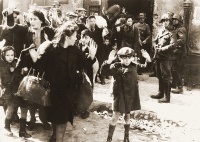Fascism
From The Art and Popular Culture Encyclopedia
| Revision as of 12:04, 6 August 2014 Jahsonic (Talk | contribs) ← Previous diff |
Revision as of 12:05, 6 August 2014 Jahsonic (Talk | contribs) Next diff → |
||
| Line 6: | Line 6: | ||
| == See also == | == See also == | ||
| *[[First they came...]] | *[[First they came...]] | ||
| - | *[[Fascism architecture]] | + | *[[Fascist architecture]] |
| *[[Fascism and the avant-garde]] | *[[Fascism and the avant-garde]] | ||
| *[[Manifesto of the Fascist Intellectuals]] | *[[Manifesto of the Fascist Intellectuals]] | ||
Revision as of 12:05, 6 August 2014

Illustration: A Child at Gunpoint (1943) from the Stroop Report
|
Related e |
|
Featured: |
Fascism is an authoritarian political ideology (generally tied to a mass movement) that considers individual and other societal interests subordinate to the needs of the state, and seeks to forge a type of national unity, usually based on ethnic, cultural, or racial attributes. Various scholars attribute different characteristics to fascism, but the following elements are usually seen as its integral parts: nationalism, authoritarianism, militarism, totalitarianism, anti-communism and opposition to economic and political liberalism.
The governments most often considered to have been fascist include the Mussolini government in Italy, which invented the word; Nazi Germany under Adolf Hitler, but other similar movements existed across Europe in the 1920s and 1930s.
See also
- First they came...
- Fascist architecture
- Fascism and the avant-garde
- Manifesto of the Fascist Intellectuals
In fiction
Further reading
- The Mass Psychology of Fascism (1933) by Wilhelm Reich
- The Origins of Totalitarianism (1951) by Hannah Arendt
- Fascinating Fascism (1975), an essay by Susan Sontag
- Sex Drives: Fantasies of Fascism in Literary Modernism (2002) by Catherine Laura Frost
- The Seduction of Unreason (2004) by Richard Wolin

